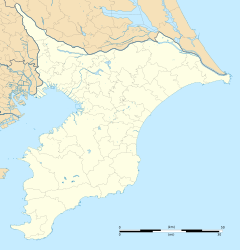Ashikajima Station
 The station entrance in July 2023 | |||||||||||
| General information | |||||||||||
| Location | 8505 Kobatake-shinmachi, Chōshi-shi, Chiba-ken 288-0021 Japan | ||||||||||
| Coordinates | 35°43′18″N 140°51′49″E / 35.72167°N 140.86361°E | ||||||||||
| Operated by | Choshi Electric Railway | ||||||||||
| Line(s) | Choshi Electric Railway Line | ||||||||||
| Distance | 3.6 km from Chōshi | ||||||||||
| Platforms | 1 (1 side platform) | ||||||||||
| Tracks | 1 | ||||||||||
| Construction | |||||||||||
| Parking | No | ||||||||||
| Other information | |||||||||||
| Status | Unstaffed | ||||||||||
| Station code | CD07 | ||||||||||
| History | |||||||||||
| Opened | December 1913 | ||||||||||
| Passengers | |||||||||||
| FY2010 | 147 daily | ||||||||||
| Services | |||||||||||
| |||||||||||
| |||||||||||
Ashikajima Station (海鹿島駅, Ashikajima-eki) is a railway station on the privately operated Chōshi Electric Railway Line in Chōshi, Chiba, Japan. The station is the easternmost station in the Kanto region, and a plaque erected in February 2012 stands on the station platform indicating this.[1]
Lines
[edit]Ashikajima Station is served by the 6.4-kilometre (4.0 mi) Chōshi Electric Railway Line from Chōshi to Tokawa. It is located between Nishi-Ashikajima and Kimigahama stations, and is a distance of 3.6 km (2.2 mi) from Chōshi Station.[2]
Station layout
[edit]The station is unstaffed,[2] and consists of a side platform serving a single track.
-
View of the station from the platform side in October 2015
-
The plaque describing the station as the easternmost station in the Kanto Region
History
[edit]Ashikajima Station first opened in December 1913 as a station on the Chōshi Sightseeing Railway (銚子遊覧鉄道, Chōshi Yūran Tetsudō), which operated a distance of 5.9 km (3.7 mi) between Chōshi and Inuboh.[3] The railway closed in November 1917,[3] but was reopened on 5 July 1923 as the Chōshi Railway.[2] It was so named (literally "sea lion island") because of the large numbers of sea lions seen on the coast up until the 1950s.[4] The present-day station structure was built in 1951.[5]
Ashikajima became an unstaffed station from 1 January 2008.[2]
Passenger statistics
[edit]In fiscal 2010, the station was used by an average of 147 passengers daily (boarding passengers only).[6] Passenger figures for previous years are as shown below.
| Fiscal year | Daily average |
|---|---|
| 1930 | 88[5] |
| 1950 | 442[5] |
| 1978 | 411[5] |
| 2007 | 151[7] |
| 2008 | 154[8] |
| 2009 | 161[9] |
| 2010 | 147[6] |
Surrounding area
[edit]- Ashikajima beach[4]
See also
[edit]References
[edit]- ^ ココが「関東最東端の駅」 銚子電鉄・海鹿島駅に標柱 [Easternmost station in Kanto: Choshi Electric Railway Ashikajima Station]. Chiba Nippo (in Japanese). Japan: Chiba Nippo Co., Ltd. 28 February 2012. Retrieved 28 August 2012.
- ^ a b c d Terada, Hirokazu (19 January 2013). データブック日本の私鉄 [Databook: Japan's Private Railways]. Japan: Neko Publishing. p. 208. ISBN 978-4-7770-1336-4.
- ^ a b Shirato, Sadao (March 2014). 銚子遊覧鉄道 [Chōshi Sightseeing Railway]. The Railway Pictorial (in Japanese). 64 (887). Japan: Denkisha Kenkyūkai: 108–109.
- ^ a b メルヘン駅舎(各駅案内) [Fairy tale station buildings (Station information)] (in Japanese). Choshi Electric Railway. Archived from the original on 10 May 2013. Retrieved 2 June 2014.
- ^ a b c d Shirato, Sadao (June 2011). 銚子電気鉄道(上) [Choshi Electric Railway Volume One]. Japan: Neko Publishing Co., Ltd. p. 31. ISBN 978-4-7770-5309-4.
- ^ a b 民鉄等駅別1日平均運輸状況 2010(平成22)年度 [Private railway average daily passenger figures by station (Fiscal 2010)] (Excel) (in Japanese). Japan: Chiba Prefectural Government. 2011. Retrieved 2 June 2014.
- ^ 民鉄等駅別1日平均運輸状況 2007(平成19)年度 [Private railway average daily passenger figures by station (Fiscal 2008)] (Excel) (in Japanese). Japan: Chiba Prefectural Government. 2011. Retrieved 2 June 2014.
- ^ 民鉄等駅別1日平均運輸状況 2008(平成20)年度 [Private railway average daily passenger figures by station (Fiscal 2008)] (Excel) (in Japanese). Japan: Chiba Prefectural Government. 2011. Retrieved 2 June 2014.
- ^ 民鉄等駅別1日平均運輸状況 2009(平成21)年度 [Private railway average daily passenger figures by station (Fiscal 2009)] (Excel) (in Japanese). Japan: Chiba Prefectural Government. 2011. Retrieved 2 June 2014.
External links
[edit]- Choshi Electric Railway station information (in Japanese)

